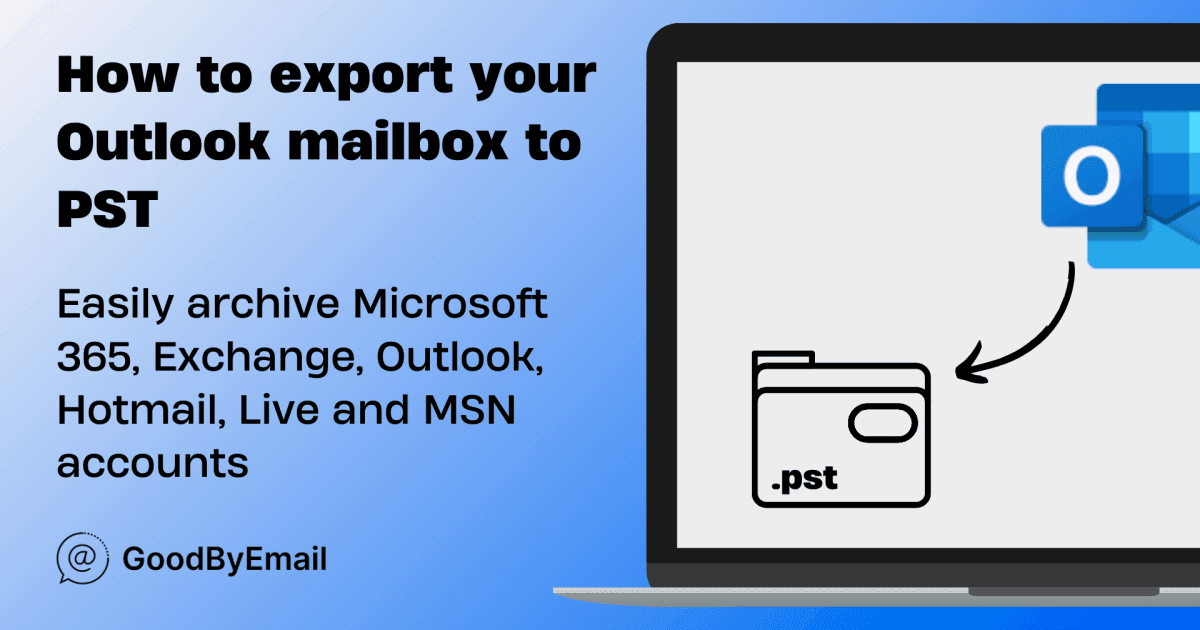How to Export Your Outlook Emails as a PST Archive in
A Quick Guide for Archiving Microsoft 365, Exchange, Outlook, Hotmail and MSN Mailboxes

Ever needed to keep a copy of all your Outlook stuff—emails, calendar, contacts, and notes? Good news: you can download it all at once, anytime you want. Here's a simple guide to do just that.
Should you be looking to export your emails to mbox check out this guide.
Export Outlook, Hotmail, MSN, Live Mailbox to PST via Web Browser
If you are using the free personal version of Outlook, Hotmail, MSN or Live.com you can export all your emails as .pst directly from your web browser by following these simple steps:
- Head over to Outlook.com and sign in.
- Navigate to the Outlook webmail export page and hit the "Export mailbox" button. This can also be accessed via the Settings icon (gear icon in the top left corner of the toolbar) > View all Outlook settings > General > Privacy and Data > Export mailbox.
- After you click to export, you'll see a message saying "Export in progress". This can take up to four days.
- Once your mailbox is ready you'll get an email with a link to download your export.
- Open the email titled "Your Requested Mailbox Export is Ready" and click on the download link.
- Choose where you want to save your mailbox (it'll be a .pst file) and click "Save" and enjoy your .pst mailbox archive.
If you have Microsoft 365 or Exchange accounts, check the alternative guide below.
Don't Miss Out!
Subscribe to GoodByEmail's newsletter. Our updates are filled with tips on how to manage your inbox.
Export Microsoft 365 or Exchange Emails to PST Using Outlook App for Windows
If you're using Microsoft 365 for work, chances are you have an Exchange or IMAP account. Here's how you can back up your email folders and contacts to a .pst file with the Microsoft Outlook app:
- Go to File > Open & Export > Import/Export.
- Choose Export to a file, then click Next.
- Select Outlook Data File (.pst), and click Next.
- Select the name of the email account to export, then check the Include subfolders box to ensure that everything in the account will be exported: Inbox, Calendar, Contacts, and Tasks. Click Next.
- Choose a location and name for your backup file, then click Finish.
- If you want to protect your files, set and confirm a password, then click OK.
That's it! Now you have a .pst backup of your mailbox.
Note: If you are a macOS user, you can archive your emails using the universal mbox format instead of .pst. Check our guide: Export Outlook Emails to mbox With a Simple Drag and Drop on macOS.
FAQs: Your Burning Questions Answered
- Version Limitations: Some versions of Outlook may have restrictions or lack the export feature.
- Incorrect Procedure: Ensure you're following the correct steps to export emails. Up to date export instructions for Outlook, Microsoft 365, Exchange, Hotmail, MSN and Live.com accounts can be found in this guide.
- Corrupted Outlook Profile: A corrupted profile can prevent export operations.
- Permissions: Lack of necessary permissions or administrative rights can restrict exporting.
- Large Mailbox: A very large mailbox might cause issues or delays in exporting.
- Software Issues: Outlook may have bugs or need updates.
- Large or Old Emails: Remove emails with large attachments or those that are old and no longer needed.
- Junk Mail: Clear out your Junk Email folder.
- Deleted Items: Empty the Deleted Items folder.
- Unnecessary Attachments: Remove downloaded attachments that are no longer needed.
- Duplicates: Delete any duplicate emails or contacts.
- Less Important Emails: Filter and delete less important emails, like newsletters or promotional emails.
- Consider using tools like GoodByEmail: It helps you quickly identify email senders that consume most of your Outlook storage. With this information, you can bulk delete emails that significantly impact your storage. Furthermore, GoodByEmail assists in unsubscribing from mailing lists, preventing your storage from filling up rapidly in the future. It operates without requiring access to your Outlook credentials, ensuring the privacy of your data.
- Not all emails are created equal. Emails with large attachments, such as videos, high-resolution images, or documents, can take up a significant amount of space. However, these types of emails might not be as common in your inbox.
- On the other hand, while individual emails without attachments might seem insignificant in size, having thousands of them can cumulatively occupy a substantial amount of storage.
- Tools like GoodByEmail can be invaluable in this process. It helps you quickly identify and delete all emails from the "Top Offenders", i.e. senders that are occupying the most storage. Moreover, it aids in unsubscribing from unwanted mailing lists, preventing future storage issues. The best part? It does all this without requiring access to your sensitive login credentials.
- Use the Search Bar to locate the emails you want to delete. For example, to find all emails from Amazon, use this search string: 'from:amazon'.
- Click on checkbox at the top left corner, to select all emails found. Unfortunately, Outlook doesn't offer an easy way to select all emails matching the search with a single click, so you need to do it manually.
- Manually scroll down with the mouse to force Outlook to search for all emails matching the search term.you can also use End and FN → keyboard shortcuts).
When you reach the end, select all emails with either the keyboard shortcut Ctrl + a (Win) or Cmd + a (macOS), or use the checkbox at the top left corner of Outlook. - Click the "Delete" button.
- Don't forget to empty your 'Deleted Items' folder to permanently remove the emails. It may take up to a day for the storage space change to be reflected in your account.
- If you're looking for a tool to identify the largest email senders, GoodByEmail is a unique tool in the market. It helps you quickly discover these top offenders without requiring access to your passwords, logins, or OAuth tokens.
- Deleted emails are moved to the "Deleted items" folder.
- To free up storage immediately, you need to manually empty the "Deleted items" folder.
- After emptying the trash, it might take up to a day for Outlook to update and reflect the new storage space.
- Mailbox Cleanup Tool: Found under "File" > "Tools" > "Mailbox Cleanup." This tool can help find and delete large emails and attachments, and archive old items.
- AutoArchive Feature: Automatically moves older emails from the mailbox to an archive folder.
- Check "Deleted Items": Look in the "Deleted Items" folder first. If the email is there, right-click and move it back to your Inbox.
- Recover from "Recoverable Items": If the email isn't in "Deleted Items", use "Recover Deleted Items from Server" under the "Folder" tab to access the "Recoverable Items" folder.
- Search for Email: Use Outlook's search feature if you still can't find the email.
- Check Backup: If you have a backup system, look there for the email.
- Contact Administrator: If on an Exchange server, your administrator may be able to recover it.
- Start with the Basics: Before diving into specialized tools, begin by manually deleting old, unnecessary emails, especially those with large attachments. Remember, emails in the "Promotions" or "Spam" tabs can often be deleted without much thought.
- Empty the Trash: Deleted emails remain in the "Trash" folder for 30 days. Make it a habit to empty this folder regularly to free up storage immediately.
- Use Outlook's Tools: Mailbox Cleanup Tool can help identify email with large attachments.
- Third-Party Tools: For a more detailed cleanup, consider using specialized tools. One such tool is GoodByMail. For a detailed guide on how to use it effectively and safely, check out this article. It provides a privacy-first approach to cleaning up your Outlook inbox without compromising your personal data.
- Regular Maintenance and Unsubscribing: To prevent your Outlook storage from filling up quickly in the future, consider setting aside time once a month for a quick cleanup. Additionally, GoodByEmail assists users in unsubscribing from unwanted mailing lists, which can significantly mitigate the risks of inbox overload. This proactive approach not only frees up storage but also ensures a clutter-free inbox experience.
How do I export all my emails from Outlook?
How do I export all my emails from Outlook?
Why can't I export my Outlook emails?
Why can't I export my Outlook emails?
How do I export Outlook emails from my browser?
How do I export Outlook emails from my browser?
What can I delete when Outlook storage is full?
What can I delete when Outlook storage is full?
How do I download Outlook emails?
How do I download Outlook emails?
Will deleting emails free up storage?
Will deleting emails free up storage?
How can I bulk delete thousands of emails in Outlook at once?
How can I bulk delete thousands of emails in Outlook at once?
Why is my Outlook storage full even after deleting thousands of emails?
Why is my Outlook storage full even after deleting thousands of emails?
Does Microsoft offer a cleanup tool for Outlook?
Does Microsoft offer a cleanup tool for Outlook?
What are the steps to recover deleted email in Outlook?
What are the steps to recover deleted email in Outlook?
How to safely clean emails and free up a significant amount of Outlook storage?
How to safely clean emails and free up a significant amount of Outlook storage?
Clean up your email inbox with way less effort. Check out GoodByEmail and discover why your inbox is out of storage. With GoodByEmail's help you can mass-delete emails from unwanted top offenders and unsubscribe from undesired mailing lists with a single click. It's the only truly secure option on the market, your emails never leave your device.
Quick plug: Clean up your email, privacy-first 💪
Isn’t it frustrating to constantly receive that "Your storage is 95% full" message?
Scared of using Email Cleaning, Unsubscribe or Declutter tools that snoop around your emails, even though they swear they are safe?
We got your back! If you haven’t tried GoodByEmail, it’s about time. Not only does it identify which email senders—many of whom you likely don’t care about anymore—are consuming all your storage space, but it also allows you to effortlessly unsubscribe from mailing lists with complete safety!
GoodByEmail uses a unique privacy-first approach by design: It simply cannot connect directly to your email provider. It does not require you to share any logins, credentials, oauth tokens, nor any sort of invasive permissions whatsoever. All the processing happens on your computer and no emails are ever uploaded to GoodByEmail's servers. Plus, you can even use it offline for maximum privacy!
Could you really trust other cleaning solutions available in the market, knowing they have direct access to your emails? Some services monetize by selling your data. Even if they claim it's secure, it raises concerns about the accessibility and potential misuse of your personal information.
GoodByEmail works with every email provider, you name it: Google, Microsoft, Fastmail, AOL, Yahoo Mail, iCloud, Office 365, Outlook, Zoho, Bluehost Mail, Namecheap Mail, Alibaba Mail, Alimail, Alyun, Gmail, Mail.com, Comcast Xfinity, Live, Hotmail, Yandex Mail, G Suite, MSN, Godaddy Mail, GoogleMail, and so many more.
You only need to make a one-time secure export of your inbox in mbox or .pst format, and GoodByEmail will find out who are the senders eating up your inbox storage space, without anyone else getting a look at your emails. Plus, you can also easily unsubscribe from those pesky subscription emails. It’s easy to do! Need help? This guide has a step-by-step.
So, what did you like about this post? Come say hello on X!
Loading X...
Wondering where to find us?
Follow us on X:
